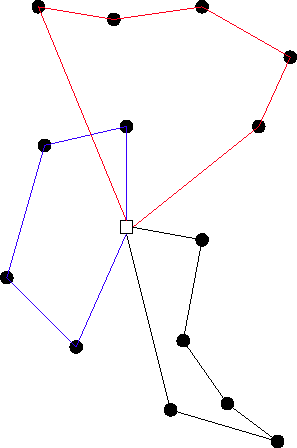



Given a graph $\graph$, compute the shortest tour linking all nodes.

Given a graph $\graph$, a set of customer demands, and a set of identical vehicles $V$, compute the shortest routing so that all customers are visited once.

Relaxation of the VRP where customers can be visited more than once.
| 1 | 2 | 3 | 4 | 5 | 6 | 7 | 8 | 9 | |
| sc | 29.31 | 522.84 | 72.99 | 222.91 | 447.78 | 664.57 | (0.45%) | 4.58 | 160.73 |
|---|---|---|---|---|---|---|---|---|---|
| sf | 27.82 | 806.01 | 664.07 | 207.41 | (1.48%) | (2.15%) | (1.09%) | 4.61 | 183.37 |
| fc | 19.83 | 598.22 | 506.86 | 438.87 | (1.37%) | (1.10%) | (1.53%) | 27.21 | 161.06 |
| ff | 58.84 | (0.36%) | (0.26%) | 517.95 | (1.65%) | (3.51%) | (3.16%) | 18.78 | 438.17 |
| CP | MIP | CP (1min) + MIP | |||||||||
|---|---|---|---|---|---|---|---|---|---|---|---|
| Value | Best (%) | Diff (%) | Value | Best (%) | Diff (%) | Gap (%) | Value | Best (%) | Diff (%) | Gap (%) | |
| small | 49303 | 0.83 | 0.95 | 48852 | 8.83 | 0.00 | 0.74 | 48850 | 90.34 | 0.01 | 0.79 |
| medium | 51698 | 7.73 | 3.83 | 51199 | 38.98 | 2.79 | 6.97 | 50446 | 53.29 | 1.46 | 6.12 |
| large | 52518 | 7.73 | 5.08 | 52200 | 26.25 | 4.17 | 9.85 | 50646 | 65.74 | 1.56 | 7.68 |
Thank you for your attention!